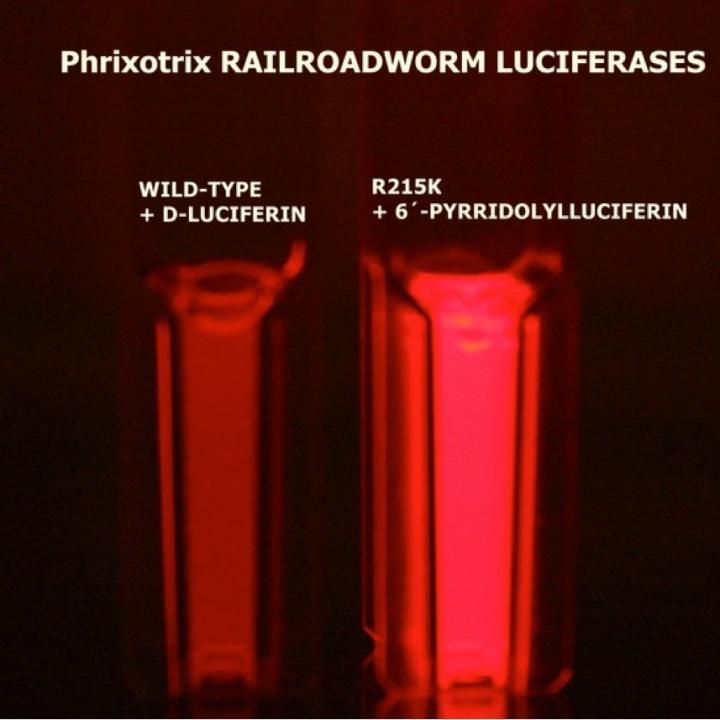Luciferin-luciferase system developed in collaboration with Japanese researchers produces brighter and longer-lasting far red light. The innovation can be used to image cells and tissues for diagnosis and biomedical research.

Credit: International Journal of Molecular Sciences
Researchers at the Federal University of São Carlos (UFSCar) in the state of São Paulo, Brazil, have developed a novel far red light-emitting luciferin-luciferase system that is more efficient than those available commercially. An article on the subject is published in the International Journal of Molecular Sciences.
The study was supported by São Paulo Research Foundation – FAPESP via the Thematic Project “Arthropod bioluminescence: biological diversity in Brazilian biomes, biochemical origin, structural/functional evolution of luciferases, molecular differentiation of lanterns, biotechnological, environmental and educational applications”, for which the principal investigator is Vadim Viviani, a biochemist and professor at UFSCar.
“We obtained a novel luciferin-luciferase system that produces far red light at the wavelength of 650 nanometers and emits the brightest bioluminescence ever reported in this part of the spectrum. It’s a highly promising result for bioluminescence imaging of biological and pathological processes in mammalian tissues,” Viviani told.
Luciferases are enzymes that catalyze the oxidation of luciferins, compounds present in some animals, algae and fungi. The oxidation reaction is responsible for the phenomenon of bioluminescence, which consists of the emission of light at wavelengths ranging from blue to red.
The firefly’s luciferin-luciferase system is widely used to help produce images of cell cultures and live animal models. It helps physicians monitor metastasis, for example, and see how tumors respond to treatment. It is also used to follow the viral infection process and the effects of candidate drugs on viruses, including the novel coronavirus.
“Red bioluminescence is preferred when imaging biological or pathological processes in mammalian tissues because hemoglobin, myoglobin and melanin absorb little long-wavelength light. Detection is best of all in the far red and near-infrared bands, but bioluminescent systems that naturally emit far red light don’t exist,” Viviani said.
“Some genetically modified forms of luciferase and synthetic analogs of natural luciferins are produced commercially. In conjunction, they produce light at wavelengths as long as 700 nanometers, but the light produced by these artificial systems is generally much weaker and more short-lived than light from natural bioluminescent systems.”
Viviani and collaborators used genetic engineering to modify luciferase from the Railroad worm Phrixothrix hirtus, the only luciferase that naturally emits red light, cloned by Viviani two decades ago. This they combined with luciferin analogs synthesized by colleagues at the University of Electro-Communications in Tokyo, Japan. The result was a much more efficient far red luciferin-luciferase system.
“Our best combination produces far red at 650 nanometers, three times brighter than natural luciferin and luciferase, and roughly 1,000 times brighter than the same luciferase with a commercial analog,” Viviani said.
“Besides the long wavelength and intense brightness, our combination has better thermal stability and cell membrane penetrability. Above all, it produces more lasting continuous bioluminescence, taking at least an hour to decay and significantly facilitating the real-time imaging of biological and pathological processes.”
###
The project was a continuation of a PhD thesis recently defended by Vanessa Bevilaqua on the effect of synthetic luciferin analogs on red luciferase from Phrixothrix. The other co-authors are PhD candidate Daniel Sousa, Gabriel Pelentir with a scientific initiation grant, and Michio Kakiuchi and Takashi Hirano in Japan.
About São Paulo Research Foundation (FAPESP)
The São Paulo Research Foundation (FAPESP) is a public institution with the mission of supporting scientific research in all fields of knowledge by awarding scholarships, fellowships and grants to investigators linked with higher education and research institutions in the State of São Paulo, Brazil. FAPESP is aware that the very best research can only be done by working with the best researchers internationally. Therefore, it has established partnerships with funding agencies, higher education, private companies, and research organizations in other countries known for the quality of their research and has been encouraging scientists funded by its grants to further develop their international collaboration. You can learn more about FAPESP at http://www.
Media Contact
heloisa reinert
[email protected]
Original Source
https:/
Related Journal Article
http://dx.




